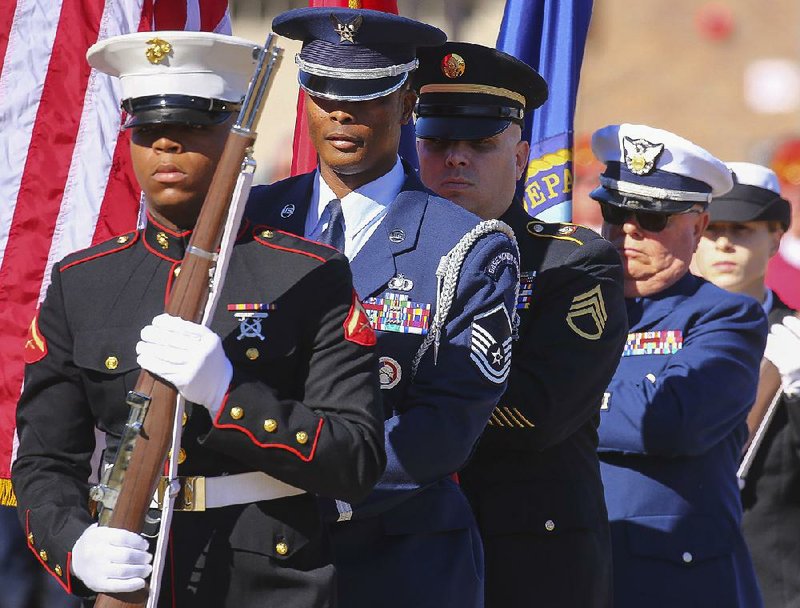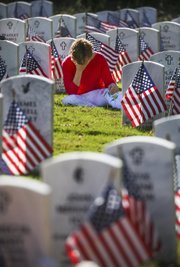When the state Veterans Home in North Little Rock welcomes its first occupants next month, it will mark the first time in four years that two state-run nursing homes for veterans are operating simultaneously.
The North Little Rock home's 96 beds, combined with 108 at the Veterans Home in Fayetteville, raise the capacity at such state-run nursing centers to 204. That's less than one-third of the estimated 653 beds needed statewide, according to a 2009 study by the U.S. Department of Veterans Affairs.
Officials and advocates said the new campus is uniquely tailored to provide a homey environment for veterans, though Matt Snead, director of Arkansas' Veterans Affairs Department, said the state is unlikely to build and operate a third home in the same mold, as officials instead look into private partnerships to increase capacity.
"You can get yourself in a bind if you just keep investing in public infrastructure, when the number of veterans is going down," Snead said in an interview. "What I think we need to do is look at more public-private partnerships."
The $24 million project -- paid for with $15.6 million in federal money and an $8.4 million state contribution -- was publicly unveiled at the state's Veterans Day celebration. Gov. Asa Hutchinson, U.S. Sens. John Boozman and Tom Cotton and other federal, state and local officials attended.
"This facility is incredible," Hutchinson said. "For all of you that supported it, this is a day we can rejoice that we have done something that our veterans wanted, that they have supported and that will serve them in the future."
Snead, during public remarks, praised an array of agency employees and state officials who he said brought to light past missteps and who helped get the North Little Rock project accomplished.
"It has been a long, long journey to get to this point," said Snead, who has led the agency since February 2015. "We all know where this agency has come from."
The home fills a void created in central Arkansas when the state's Veterans Home in Little Rock was closed in 2012. Inspectors estimated then that it would cost more than $10 million to make structural repairs. The home also was found to have improperly collected about $600,000 in fees from residents despite a change in federal law prohibiting that practice.
Also that year, the nursing-home watchdog wing of the state Department of Human Services cited the Fayetteville home for 22 patient-care violations, including medication errors and unsanitary living conditions. The home, previously flagged over allegations of neglect, has since achieved a five-star rating from the federal Centers for Medicaid and Medicare.
Aside from operating the two nursing homes, the state VA maintains two cemeteries and, from regional offices, assists the state's 250,000 veterans to access federal Veterans Affairs benefits.
Veterans' spouses, as well as parents, siblings or children of veterans killed in service, are eligible to live in the North Little Rock home.
Of more than 300 people who initially expressed interest in living at the new campus, 175 have followed up with the state's VA, said Sarah Jones, the department's director of public affairs. Those candidates will be screened "based on need to be placed in a nursing facility and method of payment," Jones said.
Residents can pay their own way to live at the home or obtain federal vouchers based on their age, income or service-related disability.
The first six residents, who will pay privately, are expected to move in next month, Jones said. The campus won't reach capacity for at least a year because it still needs certifications to receive Medicaid, Medicare and federal VA funding, Jones said.
"When we obtain that, we will begin slowly filling up the homes in the facility," Jones said.
A collection of eight 12-resident cottages, the North Little Rock Veterans Home is situated on a former nine-hole golf course near the Eugene J. Towbin Healthcare Center. Of 152 state-run veterans homes in the U.S., just three use this so-called small-house design, according to the state VA.
Arkansas Veterans of Foreign Wars Commander Rosalyn Cox, recalling her father's stay in a Florida home for veterans, said the setup affords residents privacy and dignity.
"This is absolutely a turnaround," Cox said, noting that her father and his fellow residents had "no privacy whatsoever" in a nursing home she compared to "open-bay barracks."
The home is the state's first strictly designed to serve veterans and their families.
Each resident has a private room and bathroom plus access to common spaces inside the 14,000-square-foot cottages. Each building contains a spa and salon, laundry room, kitchen, quiet room for playing cards or talking with visitors and a living area -- with televisions donated by the Arkansas VFW.
Staff members will prepare meals and launder residents' clothes, but the veterans also may choose to do that themselves.
"As we age, people in their own good hearts feel like they're helping us by not letting us do anymore," said Kathie Gately, the home's administrator, during a tour. "You want to be engaged and involved in life, don't you? That's what makes you want to get up the next day."
Trying to anticipate veterans' needs, builders installed low-slung countertops and appliances. A soft color scheme was selected with consideration that eyesight deteriorates as people age, said Tamara Switser, the state VFW's chief of staff.
Officials said there's space at the North Little Rock site to add four more cottages, or 48 more beds, in the future.
Sherry Nellums, 52, who attended Friday's ceremony on behalf of her older brother, a Navy veteran who lives out of town, praised the facility but said veterans assistance is generally lacking.
"It's beautiful, but it's not enough," Nellums said. "There are veterans living in the street and in the woods."
Nellums said she feels local, state and federal agencies need to do a better job identifying struggling veterans and providing them with services like counseling and job training to help their "reintegration into society."
Confronted with more veterans who need long-term care than the state's capacity, Snead said he does not believe the answer is to build more state-run facilities.
Instead, Snead said he wants to develop private partnerships that meet specific nursing-home standards so the state won't have excess resources when the veteran population is projected to decline.
"We know that this home accommodates to a certain standard for veterans, and we can push [other nursing homes] there," Snead said. "I don't know how that would look, but that's, in general, what we're trying to do."
An estimated 11.8 million veterans age 60 or older live in the U.S. today, according to the federal VA. That number is expected to drop to 9 million in 2026 and 8.7 million in 2036, according to forecasts.
"We're losing the draft-era veterans," Snead said.
Nellums said she feels like the biggest gap in veterans services are local efforts to determine who needs what service. Whether the care is provided by a public or private agency does not concern her, she said.
"It doesn't matter who does the job as long as the job is done well," Nellums said.
A Section on 11/12/2016


